AMD Radeon HD 7970 Review: 28nm And Graphics Core Next, Together As One
by Ryan Smith on December 22, 2011 12:00 AM EST- Posted in
- GPUs
- AMD
- Radeon
- ATI
- Radeon HD 7000
Power, Temperature, & Noise
As always, we wrap up our look at a new video card with a look at the physical performance attributes: power consumption, temperatures, and noise. With new process nodes being the lifeblood of the GPU industry, each new process gives GPU manufacturers a chance to move their product along a continuum; do they take advantage of a power consumption reduction for the same performance level, a performance increase for the same power consumption, or something in between? In AMD’s case they’ve chosen to try to maximize performance within Cayman’s power budget, which means power, temperature, and noise should be similar to what we’ve seen with 6970, cooler improvements not withstanding.
Before we get into the charts, it’s worth noting right now that we don’t have a good idea of what 7970’s operational voltage is, as we don’t have any tools that can read 7970’s VRMs. We believe it’s close to Cayman’s, but this is something that will require confirmation in the future.
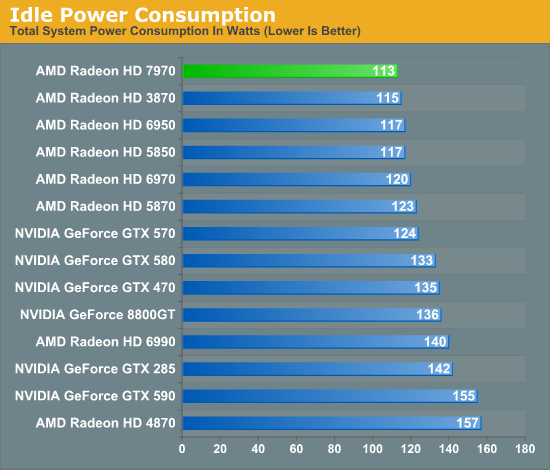
Starting as always with idle power, we can immediately see the benefits of the work AMD has put into idle power usage with Southern Islands. AMD has been working hard to reduce idle power consumption since the 4870 and at this point they’ve finally beaten even the 3870, which was a relatively small GPU using GDDR3 RAM. AMD’s official typical idle TDP here is 15W, and we have little doubt they’re going to continue to whittle that number down on future generations.
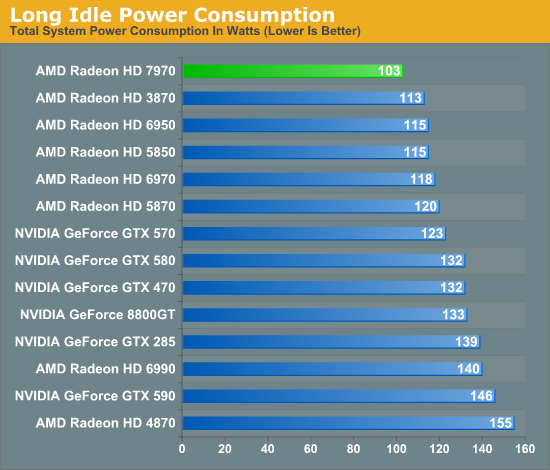
While we’re looking at idle power, we also wanted to take a look at AMD’s “long idle” scenario, where a blanked display or being slave GPU in a multi-GPU setup gives a GPU the opportunity to go into a deeper sleep state as it’s not needed for any work. Through ZeroCore Power AMD is able to shut off virtually every aspect of Tahiti when in a long idle state, allowing AMD to reduce the power consumption of 7970 to under 3W. Meanwhile for every other card there’s a very slight gain to be had in long idle because the GPU can power down all of its display transmitters, but it’s not nearly as effective as shutting down the entire GPU, which is why 7970 has a 10W advantage at the wall versus the next closest GPU.
As we said earlier in our look at ZeroCore Power technology, while the numbers are impressive enough, for the desktop the real use will be in multi-GPU systems as slave GPUs can be put in a ZCP state even while the master GPU is awake and working, significantly reducing idle power and noise in multi-GPU systems.

Moving on to our load power tests, based on our testing we have swapped out Crysis for Metro 2033 in this iteration of our benchmark suite as Metro 2033 was proving to be a bit more strenuous on our GPUs and is the only game to ever trigger PowerTune on the 6970.
Looking at Metro it’s clear that the smaller fabrication process for 6970 has allowed AMD to achieve a lower power consumption level relative to their gaming performance – the 7970 leads the GTX 580 by 20-30% in performance while consuming 34W less at the wall. At the same time this test calls into question AMD’s power targets. We’re clearly drawing more power than the 6970 – 21W more to be precise – and while this could be explained by CPU power consumption I’m not convinced that’s the case.
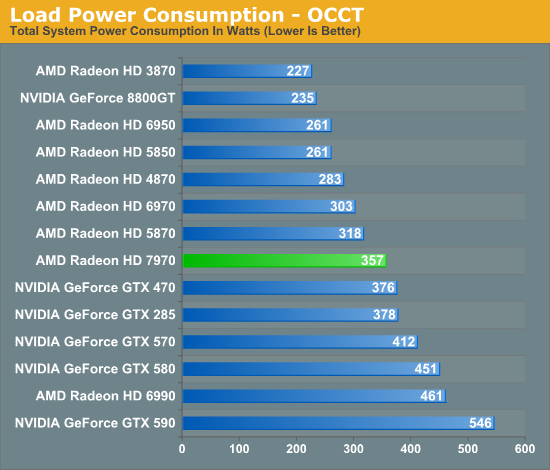
As for our pathological power consumption test we’ve moved on to OCCT, which at this point in time escapes NVIDIA’s throttling mechanism and in spite of the presence of PowerTune still manages to be a hardware workload on AMD’s GPUs than FurMark. OCCT backs up our earlier data from Metro that 7970 draws more power than 6970 even with the similar power targets. We’re drawing 50W more at the wall, which on paper at least would put 7970’s power consumption closer to 280W if AMD’s original 250W target for 6970 is still correct. If all of this is correct, then it calls into doubt AMD’s published power targets, as it looks like AMD has made a power/performance tradeoff with 7970 by trading slightly higher power consumption for what would be higher performance.

Up next is our look at idle temperatures. All of the last generation GPUs were highly competitive here and as a result it’s a tough crowd as there’s relatively little room to further reduce a GPU’s temperature. Nevertheless the 7970 manages to squeak by the competition, with a recorded idle temperature of 34C, 1C lower than the GTX 580 and 2C lower than the 6970.
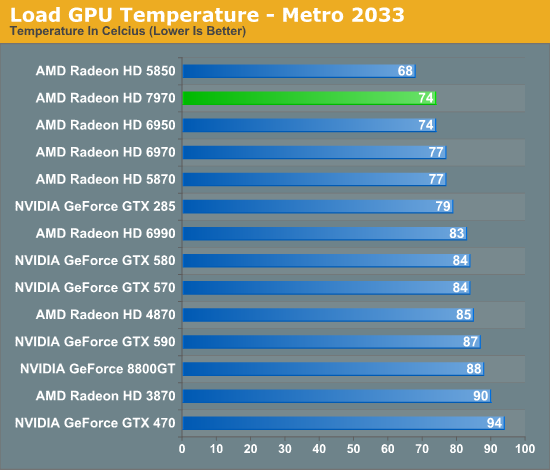
Moving on to temperatures under Metro, the results are quite surprising: the 7970 does really, really good here given its power consumption. At 74C the only cooler video cards are the 6850 and 5850, both of which are lower tier, lower power versions of higher end parts. Part of this can be traced back to AMD’s cooling optimizations such as moving back to a full slot exhaust vent, but I don’t believe that’s a full explanation. We’ll get back to this when we’re looking at noise.
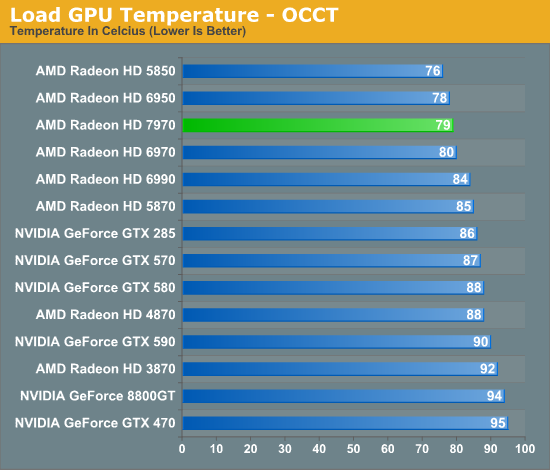
While the overall numbers are higher in OCCT, the relative rankings are unchanged from Metro. The only cooler cards in this lineup are the 6950 and 5850. Here the 7970 hits 79C, while the 6970 is slightly behind at 80C, and the GTX 500 series is in the upper 80s.
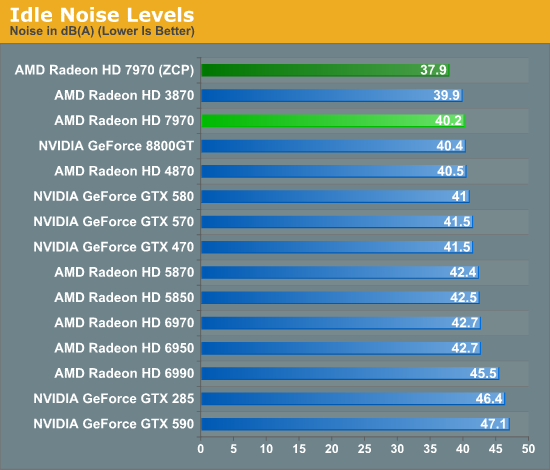
Last we have our look at noise, starting with idle noise. Much like our idle temperatures most single-GPU video cards tend to cluster together within 1dB, but the 7970 has managed to silence most of the rest of the pack, with a recorded noise level of 40.2dB. More impressive perhaps is the 7970 when in its Zero Core Power state. Because the fan turns off, the card is silent; 37.9dB(A) is the noise floor of our testbed.
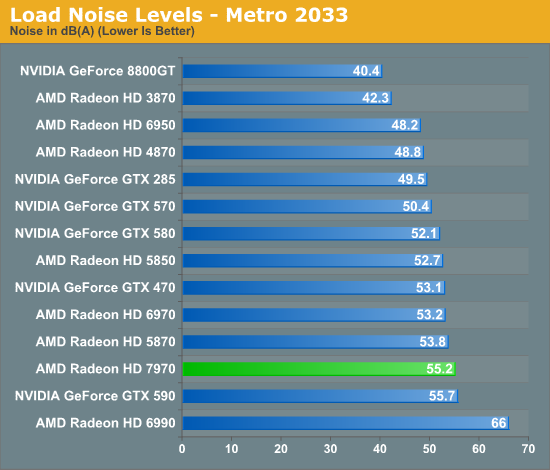
Moving on to our load noise measurements the full picture of the 7970’s cooling performance finally starts coming together. We’ve seen that the 7970 is a cool card, but is it a quiet card? The numbers say no. The 7970 is 3dB louder than the GTX 580 and 2dB louder than the 6970 even with its physical cooling improvements. Based on this combined with our temperature data it’s clear that AMD has targeted aggressive cooling over silence, whereas NVIDIA traditionally targets silence over aggressive cooling. When it comes to our testbed AMD has probably overdone it – we could easily exchange 10C for less noise – but with a wide range of computers in the world it’s hard to tell from a single testbed whether the cooling here is genuinely too aggressive for everyone, or if it’s the opposite. What isn’t in question is that the 7970 is going to be moderately loud, which coming from AMD is a surprising development.
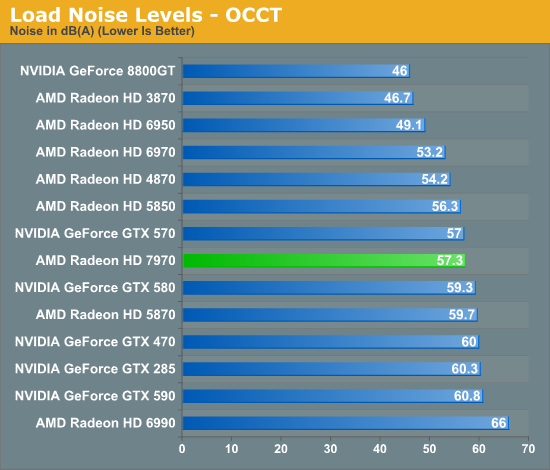
Once again with OCCT the numbers are higher, but the facts are largely the same. The 7970 is now quieter than the GTX 580 due to PowerTune, but it’s now 4dB louder than the 6970. Unlike Metro 57.3dB of noise is in the middle of the pack, but it stands to reason that AMD could have been a bit less aggressive on their fan speeds and made a quieter card as a result.










292 Comments
View All Comments
Zingam - Thursday, December 22, 2011 - link
I think this card is a kinda fail. Well, maybe it is a driver issue and they'll up the performance 20-25% in the future but it is still not fast enough for such huge jump - 2 nodes down!!!It smell like a graphics Bulldozer for AMD. Good ideas on paper but in practice something doesn't work quite right. Raw performance is all that counts (of course raw performance/$).
If NVIDIA does better than usual this time. AMD might be in trouble. Well, will wait and see.
Hopefully they'll be able to release improved CPUs and GPUs soon because this generation does not seem to be very impressive.
I've expected at least triple performance over the previous generation. Maybe the drivers are not that well optimized yet. After all it is a huge architecture change.
I don't really care that much about that GPU generation but I'm worried that they won't be able to put something impressively new in the next generation of consoles. I really hope that we are not stuck with obsolete CPU/GPU combination for the next 7-8 years again.
Anyway: massively parallel computing sounds tasty!
B3an - Thursday, December 22, 2011 - link
You dont seem to understand that all them extra transistors are mostly there for computing. Thats mostly what this was designed for. Not specifically for gaming performance. Computing is where this card will offer massive increases over the previous AMD generation.Look at Nvidia's Fermi, that had way more transistors than the previous generation but wasn't that much faster than AMD's cards at the time. Because again all the extra transistors were mainly for computing.
And come on LOL, expecting over triple the performance?? That has never happened once with any GPU release.
SlyNine - Friday, December 23, 2011 - link
The 9700pro was up to 4x faster then the 4600 in certian situations. So yes it has happened.tzhu07 - Thursday, December 22, 2011 - link
LOL, triple the performance?Do you also have a standard of dating only Victoria's Secret models?
eanazag - Thursday, December 22, 2011 - link
I have a 3870 which I got in early 2007. It still does well for the main games I play: Dawn of War 2 and Starcraft 2 (25 fps has been fine for me here with settings mostly maxed). I have eyeing a new card. I like the power usage and thermals here. I am not spending $500+ though. I am thinking they are using that price to compensate for the mediocre yields they getting on 28nm, but either way the numbers look justified. I will be look for the best card between $150-$250, maybe $300. I am counting on this cards price coming down, but I doubt it will hit under $400-350 next year.No matter what this looks like a successful soft launch of a video card. For me, anything smokes what I have in performance but not so much on power usage. I'd really not mind the extra noise as the heat is better than my 3870.
I'm in the single card strategy camp.
Monitor is a single 42" 1920x1200 60 Hz.
Intel Core i5 760 at stock clocks. My first Intel since the P3 days.
Great article.
Death666Angel - Thursday, December 22, 2011 - link
Can someone explain the different heights in the die-size comparison picture? Does that reflect processing-changes? I'm lost. :D Otherwise, good review. I don't see the HD7970 in Bench, am I blind or is it just missing.Ryan Smith - Thursday, December 22, 2011 - link
The Y axis is the die size. The higher a GPU the bigger it is (relative to the other GPUs from that company).Death666Angel - Friday, December 23, 2011 - link
Thanks! I thought the actual sizes were the sizes and the y-axis meant something else. Makes sense though how you did it! :-)MonkeyPaw - Thursday, December 22, 2011 - link
As a former owner of the 3870, mine had the short-lived GDDR4. That old card has a place in my nerd heart, as it played Bioshock wonderfully.Peichen - Thursday, December 22, 2011 - link
The improvement is simply not as impressive as I was led to believed. Rumor has it that a single 7970 would have the power of a 6990. In fact, if you crunch the numbers, it would be at least 50% faster than 6970 which should put it close to 6990. (63.25% increase in transistors, 40.37% in TFLOP and 50% increase in memory bandwidth.)What we got is a Fermi 1st gen with the price to match. Remember, this is not a half-node improvement in manufacturing process, it is a full-node and we waited two years for this.
In any case, I am just ranting because I am waiting for something to replace my current card before GTA 5 came out. Nvidia's GK104 in Q1 2012 should be interesting. Rumored to be slightly faster than GTX 580 (slower than 7970) but much cheaper. We'll see.